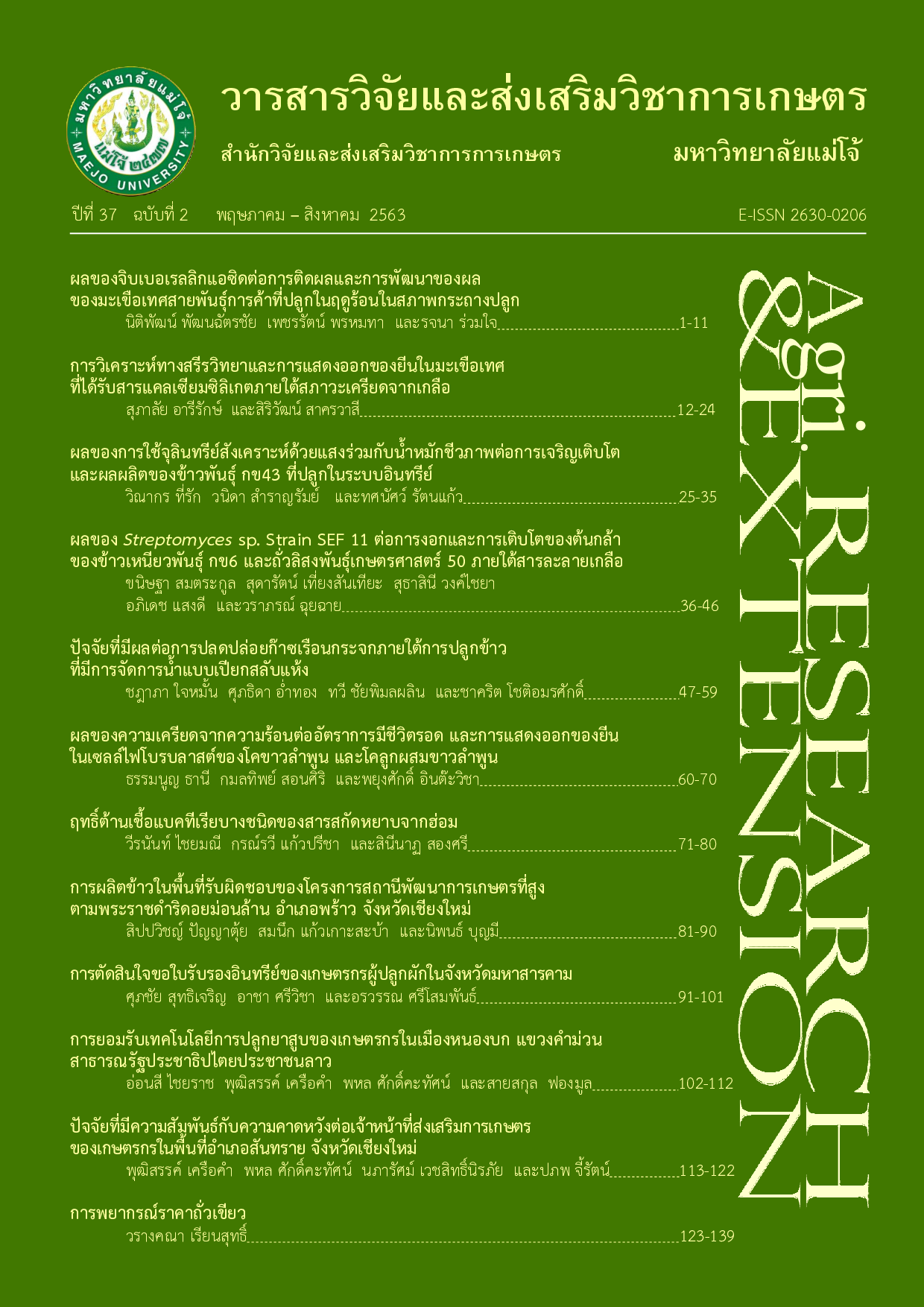ปัจจัยที่มีผลต่อการปลดปล่อยก๊าซเรือนกระจกภายใต้การปลูกข้าว ที่มีการจัดการน้ำแบบเปียกสลับแห้ง
คำสำคัญ:
ก๊าซเรือนกระจก, ถ่านชีวภาพ, เนื้อดิน, ระยะการเจริญเติบโตของข้าวบทคัดย่อ
งานวิจัยนี้มีวัตถุประสงค์เพื่อศึกษาปัจจัยที่มีผลต่อการปลดปล่อยก๊าซมีเทนและคาร์บอนไดออกไซด์ภายใต้การปลูกข้าวที่มีการจัดการน้ำแบบเปียกสลับแห้งและศึกษาความสัมพันธ์ของการเจริญเติบโตของข้าวต่อการปลดปล่อยก๊าซมีเทนและคาร์บอนไดออกไซด์ภายใต้สภาวะต่างๆ วางแผนการทดลองแบบ 2x4 Factorial in RCBD (4 ซ้ำ) ผลการทดลองพบว่า การปลูกข้าวภายใต้การจัดการน้ำแบบเปียกสลับแห้งมีเนื้อดิน การใช้ปุ๋ยเคมีร่วมกับถ่านชีวภาพ รวมถึงระยะการเจริญเติบโตของต้นข้าวเป็นปัจจัยที่ส่งผลต่อการปลดปล่อยก๊าซเรือนกระจก ในการทดลองนี้เนื้อดินร่วนเหนียวปนทราย ที่มีการใช้ปุ๋ยเคมีร่วมกับถ่านชีวภาพ 100% ในระยะข้าวตั้งท้อง และระยะน้ำนม มีการปลดปล่อยก๊าซมีเทนออกมาต่ำที่สุด มีค่า 0.60 และ 0.57 gCH4m-2d-1 ขณะที่การปลดปล่อยก๊าซมีเทนสูงที่สุดอยู่ในระยะข้าวแตกกอและระยะตั้งท้องในกรรมวิธีควบคุม ส่วนกรรมวิธีที่มีการใช้ปุ๋ยเคมีร่วมกับถ่านชีวภาพ 100% ของเนื้อดินทรายปนร่วน ในระยะข้าวตั้งท้อง มีการปลดปล่อยก๊าซคาร์บอนไดออกไซด์ออกมาต่ำที่สุดมีค่า 1.05 gCO2m-2d-1 ส่วนการเจริญเติบโตของข้าวพบว่า เนื้อดินร่วนเหนียวปนทรายที่มีการใส่ปุ๋ยเคมีร่วมกับถ่านชีวภาพ มีผลทำให้ความสูงและจำนวนกอของต้นข้าวสูงกว่าเนื้อดินทรายปนร่วนอย่างมีนัยสำคัญทางสถิติ (P<0.05)
เอกสารอ้างอิง
Aumtong, S. 2018. Paddy Soil and Management. Chiang Mai: Faculty of Agricultural Production, Maejo University. 486 p. [in Thai]
Buachan, N. 2014. Carbon Stock in RiceCultivated Soils with Different Soil Management. Master Thesis. Kasetsart University. 91 p. [in Thai]
Chumvong, A. and B. Kwanyuen. 2008. Watermanagement in paddy field for reduction of environmental impacts on methane. 12 p. In Research Report. Bangkok: Kasetsart University. [in Thai]
Fynn, R.W.S., R.J. Haynes, and T.G. O’ Connor. 2003. Burning causes long-term change in soil organic matter content of a South African grassland. Soil Biological and Biochemistry 35: 677-687.
Ghani, A.D., M. Dexter and K.W. Perrott. 2003. Hot water extractable carbon in soils: a sensitive measurement for determining impacts of fertilization, grazing and cultivation. Soil Biological and Biochemistry 35: 1231-1243.
Kohkhoo, R., N. Chaichana, W. Chai-arree, T. Pornprom, C. Malumpong and T. Pakoktom. 2015. Methane Emissions from Water and Weed Managements in Irrigated Paddy Rice Field. p. 431-438. In Proceedings of 53rd Kasetsart University Annual Conference. Bangkok: Kasetsart University. [in Thai]
Mc Lean, E.O. 1982. Soil pH and lime requirement. pp. 199-224. In Page A.L. Edition. Methods of Soil Analysis, Part II. Madison, WI: Chemical and Microbiological Properties, Soil Science Society of America.
Onthong, J. 2012. Soil and Plant Analysis Manual 1st. Songkla: Prince of Songkla University. 168 p. [in Thai]
Saengjan, P., S. Ro and P. Vityakon. 2015. Methane fluxes and rice yields as a function of sulfate fertilizer with incorporated rice stubble. KKU Res. J. 20(3): 337-345.
Sampanpanish, P. and N. Ruensuk. 2013. Effectof rice varieties and type of fertilizeron methane emission from paddy fields. Burapha Sci. J. 18(1): 105-115. [in Thai]
Satpathy, S.N., A.K. Rath, B. Ramakrishnan, V.R. Rao, T.K. Adhya and N. Sethunathan. 1997. Diurnal variation in methane efflux at different growth stages of tropical rice. Plant and Soil 195: 267-271.
Shao, G.C., S. Deng, N. Liu, SE. Yu, M.H. Wang and D.L. She. 2014. Effects of controlled irrigation and drainage on growth, grain yield and water use in paddy rice. European Journal of Agronomy 53: 1-9.
Smakgahn, K. and V. Saothongnoi. 2017. Effect of rising air temperature and CO2 concentration on greenhouse gases emissions from Suphanburi 1 rice variety. Veridian E-Journal, Science and Technology Silpakorn University 4(5): 131-143. [in Thai]
Sriboottha, A. and P. Saengjan. 2002. Factors influencing methane formation and emission from paddy fields. Academic Service Center Khon Kaen University J. 10(3): 42-46. [in Thai]
Srisurat, S. 2009. Reducing greenhouse gas emissions: in the case of methane gas from paddy rice fields. Journal of Social Sciences Srinakharinwirot University 12(2009): 115-122. [in Thai]
Walkley, A. and I.A. Black. 1934. An examination of the degtjareff method for determining soil organic matter and a proposed modification of the chromic acid titration method. Soil Science 37: 29-33.
Wantanabe, F.S. and S.R. Olsen. 1962. Calorimetric determination of phosphorus in water extracts of soil. Soil Science 93: 183-188.
Warnock, D.D., J. Lehmann, T.W. Kuyper and M.C. Rillig. 2007. Mycorrhizal responses to biochar in soil: concept and mechanisms. Plant and Soil 300: 9-20.
Wu, M., X. Han, T. Zhong, M. Yuan and W. Wu. 2016. Soil organic carbon content affects the stability of biochar in paddy soil. Agriculture, Ecosystems and Environment 223: 59-66.
Yagi, K. and K. Minami. 1990. Effect of organic matter application on methane emission from some Japanese paddy fields. Soil Science and Plant Nutrition 36(4): 599-610.
Yongwoon, L., J. Park, C. Ryu, K.S. Gang, W. Yang, Y.K. Park, J. Jung and S. Hyun. 2013. Comparison of biochar properties from biomass residues produced by slow pyrolysis at 500°C. Bioresource Technology 148: 196-201.
ดาวน์โหลด
เผยแพร่แล้ว
รูปแบบการอ้างอิง
ฉบับ
ประเภทบทความ
สัญญาอนุญาต
บทความนี้ได้รับการเผยแพร่ภายใต้สัญญาอนุญาต Creative Commons Attribution-NonCommercial-NoDerivatives 4.0 International (CC BY-NC-ND 4.0) ซึ่งอนุญาตให้ผู้อื่นสามารถแชร์บทความได้โดยให้เครดิตผู้เขียนและห้ามนำไปใช้เพื่อการค้าหรือดัดแปลง หากต้องการใช้งานซ้ำในลักษณะอื่น ๆ หรือการเผยแพร่ซ้ำ จำเป็นต้องได้รับอนุญาตจากวารสาร





